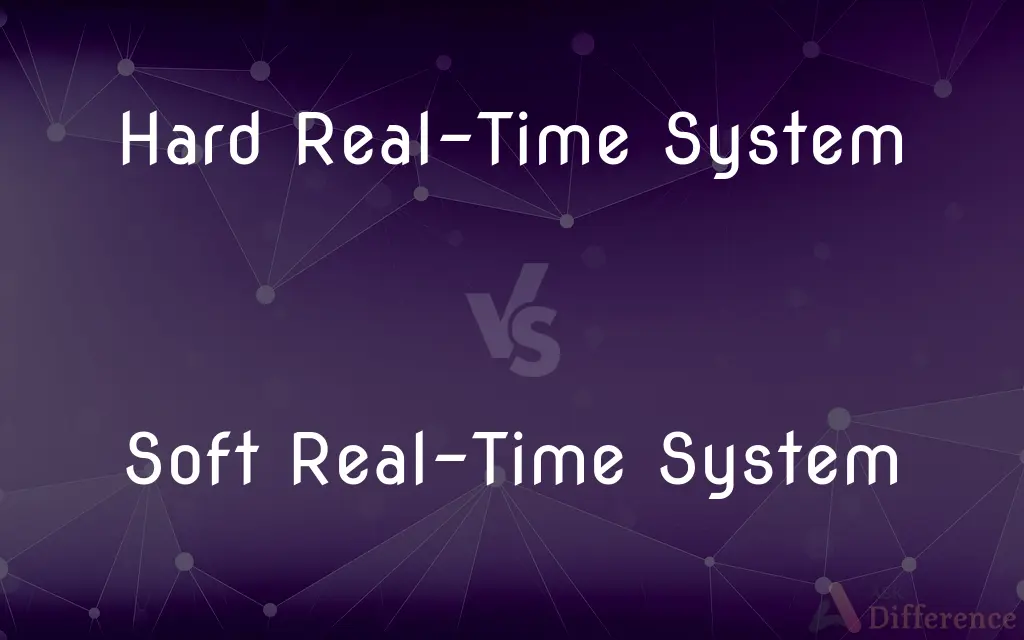Hard Real-Time System vs. Soft Real-Time System — What's the Difference?
By Tayyaba Rehman & Fiza Rafique — Published on January 30, 2024
Hard Real-Time Systems require strict timing constraints; missing a deadline can cause system failure. Soft Real-Time Systems are less rigid, tolerating some delays.

Difference Between Hard Real-Time System and Soft Real-Time System
Table of Contents
ADVERTISEMENT
Key Differences
Hard Real-Time Systems are characterized by strict timing constraints where missing a deadline can lead to catastrophic results. In contrast, Soft Real-Time Systems have more flexible deadlines, where performance degrades but doesn’t result in failure if deadlines are missed.
In a Hard Real-Time System, timely and predictable execution is crucial for system stability and safety, such as in airbag systems in vehicles. Whereas, Soft Real-Time Systems, like streaming audio, can tolerate minor delays without significant consequences.
Hard Real-Time Systems are often found in critical applications where failure could be disastrous, such as in medical life-support systems. Soft Real-Time Systems are common in less critical applications like video conferencing, where occasional lag is acceptable.
The design of Hard Real-Time Systems focuses on guaranteeing response times within the deadline, often requiring specialized hardware and software. Soft Real-Time Systems, however, prioritize overall system throughput and can often operate on general-purpose hardware.
The failure to meet a deadline in Hard Real-Time Systems is unacceptable and considered a system failure. In Soft Real-Time Systems, deadline misses are undesirable but usually don’t constitute a complete system failure.
ADVERTISEMENT
Comparison Chart
Deadline Strictness
Missing a deadline causes system failure
Deadlines are important but missing them is less critical
Application Examples
Airbag systems, industrial control systems
Video streaming, online gaming
Consequence of Deadline Miss
Catastrophic failure
Degraded performance, but no system failure
System Design
Focus on predictable execution, may need specialized hardware
Focus on throughput, often uses general-purpose hardware
Typical Use
Safety-critical systems
Convenience and entertainment applications
Compare with Definitions
Hard Real-Time System
These systems are essential in scenarios where failing to meet deadlines could cause catastrophic consequences.
Aircraft control systems are hard real-time, as delays can result in life-threatening situations.
Soft Real-Time System
Soft Real-Time Systems prioritize overall system performance, with some tolerance for delays.
In online gaming, a soft real-time system can handle some lag without ruining the game experience.
Hard Real-Time System
Hard Real-Time Systems ensure that critical tasks are completed within a fixed time.
In surgical robots, a hard real-time system is essential for precise and timely maneuvers during operations.
Soft Real-Time System
A system where deadlines are important but missing them occasionally is tolerable.
Online video streaming services are soft real-time systems, where buffering is acceptable to a degree.
Hard Real-Time System
Hard Real-Time Systems prioritize timeliness over other computing tasks.
The missile guidance system operates on a hard real-time basis to ensure accurate targeting.
Soft Real-Time System
Soft Real-Time Systems are used where an immediate response is desired, but not critical for system functionality.
A video conference call operates under a soft real-time system, where brief delays are usually acceptable.
Hard Real-Time System
A system where meeting strict timing constraints is critical to its operation.
The anti-lock braking system in cars is a hard real-time system, requiring immediate response to avoid accidents.
Soft Real-Time System
These systems aim for high performance but can cope with minor delays or performance drops.
Digital audio workstations used in music production are soft real-time, tolerating minor delays in processing.
Hard Real-Time System
A system where the correctness depends not only on the logical result but also on the time it is delivered.
Heart pacemakers must function as a hard real-time system, delivering impulses at precise intervals.
Soft Real-Time System
A system in which performance degrades if deadlines are missed, but it does not lead to complete failure.
DVR systems for TV are soft real-time, as delayed recording start times slightly affect viewing experience but don’t cause failure.
Common Curiosities
Why are deadlines crucial in Hard Real-Time Systems?
Deadlines in Hard Real-Time Systems are crucial because their failure can result in catastrophic outcomes or safety hazards.
Can Soft Real-Time Systems handle occasional delays?
Yes, Soft Real-Time Systems can handle occasional delays, as they are designed for optimal performance rather than strict timing.
Where are Soft Real-Time Systems commonly used?
They are commonly used in applications like multimedia systems, online gaming, and digital TV services.
What are typical applications of Hard Real-Time Systems?
Typical applications include critical systems like air traffic control, medical life-support machines, and industrial automation.
Can Soft Real-Time Systems be used for safety-critical tasks?
Generally, they are not recommended for safety-critical tasks due to their less stringent timing requirements.
Can Hard Real-Time Systems be used for entertainment applications?
They can be overkill for such applications, as they are designed for scenarios where timing is crucial for safety or functionality.
What is a Soft Real-Time System?
A Soft Real-Time System prioritizes timely processing but can tolerate some delays without leading to complete system failure.
What is a Hard Real-Time System?
A Hard Real-Time System is one in which the timing of task completion is critical, and missing a deadline leads to system failure.
How critical is system throughput in Soft Real-Time Systems?
System throughput is very important in Soft Real-Time Systems, as it affects overall performance and user experience.
Are Hard Real-Time Systems more expensive than Soft Real-Time Systems?
Typically, yes, due to the specialized hardware and rigorous development processes required.
What happens if a Soft Real-Time System consistently misses deadlines?
Consistent delays can degrade performance significantly, affecting user experience and system reliability.
Is it easier to develop Soft Real-Time Systems compared to Hard Real-Time Systems?
Yes, generally, because Soft Real-Time Systems have less stringent time constraints, making their development less complex.
How do Hard Real-Time Systems handle processing tasks?
They prioritize critical task processing within strict time frames, often sidelining less critical tasks.
Do Soft Real-Time Systems require special hardware?
Soft Real-Time Systems often don't require specialized hardware and can run on general-purpose systems.
Is a missed deadline acceptable in a Hard Real-Time System?
No, in Hard Real-Time Systems, missing a deadline is considered a system failure.
Share Your Discovery

Previous Comparison
API GL-04 vs. API GL-05
Next Comparison
Jitter vs. LatencyAuthor Spotlight
Written by
Tayyaba RehmanTayyaba Rehman is a distinguished writer, currently serving as a primary contributor to askdifference.com. As a researcher in semantics and etymology, Tayyaba's passion for the complexity of languages and their distinctions has found a perfect home on the platform. Tayyaba delves into the intricacies of language, distinguishing between commonly confused words and phrases, thereby providing clarity for readers worldwide.
Co-written by
Fiza RafiqueFiza Rafique is a skilled content writer at AskDifference.com, where she meticulously refines and enhances written pieces. Drawing from her vast editorial expertise, Fiza ensures clarity, accuracy, and precision in every article. Passionate about language, she continually seeks to elevate the quality of content for readers worldwide.
















































